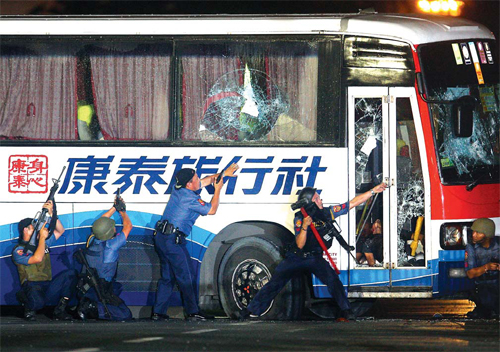-
News >World
9 killed on hijacked tourist bus in Manila
2010-08-24 06:51MANILA, Philippines – It looked like a hostage rescue in slow motion: Police creeping up on the bus with sledgehammers and smashing first one window, then another, then trying and failing to rip open the door.

Police commandos storm the bus in which 15 Hong Kong tourists were being held hostage in downtown Manila on Monday. [Agencies]When they finally got inside, authorities said, they found nine bodies: eight Hong Kong tourists and the ex-policeman who had seized the bus to demand his job back.
The bloody denouement to the 12-hour drama in the heart of the Philippine capital, witnessed live on TV, rattled a country already accustomed to kidnappings and violence. It provoked demands from the Hong Kong government for an explanation, and an acknowledgment from Philippine President Benigno Aquino III that his police need more training and equipment.It was 10:15 am Monday in Manila when Rolando Mendoza, 55 and married with three children, hitched a ride with the tourists as they visited historic sites in the city. He wore a camouflage uniform and carried an M16 rifle but didn't seem unusual in the heavily policed capital.
Then he announced that he was taking the travelers hostage to win back his job.
According to newspaper reports, the former senior inspector was among five officers who had been charged with robbery, extortion and grave threats after a Manila hotel chef filed a complaint alleging they falsely accused him of using drugs to extort money. Mendoza was fired last year but claimed he was innocent.
With the bus parked on a Manila park parade ground, Mendoza stuck leaflets on windows, handwritten in English, saying "big mistake to correct a big wrong decision," demanding media attention and threatening "big deal will start after 3 pm today."
At first, matters proceeded peacefully. The hijacker freed nine hostages -- three women, three children and two men -- leaving 15 tourists on board. Police sealed the area and brought food for the hostages, along with fuel to keep the bus' air conditioning running in the 32-degree-Celsius (90 F) heat.
Then negotiations began to go awry. Mendoza demanded a signed promise that his case would be reviewed, but its delivery was delayed for hours, in part by Manila's notorious traffic, and when it finally arrived he rejected it as insufficient.
The hijacker's brother Gregorio, a policeman, was flown in to talk to him through the driver's window but grew so agitated in claiming Mendoza had been unfairly sacked that police hustled him away, fearing he would inflame the situation.
That apparently angered Mendoza into firing a warning shot. Police made an initial attempt to board the bus, and the hijacker shot and wounded a police sharpshooter, said Nelson Yabut, head of the assault team. Single shots, then a burst of automatic fire, echoed through the night.
The Filipino bus driver managed to escape and, according to police officer Roderick Mariano, reported that Mendoza had fired at the tourists.
A freed hostage who gave only her surname, Ng, told Hong Kong reporters that she saw her husband killed by Mendoza after he tried to take him on.
"He was very brave. He rushed forward from the back of the bus. He wanted to prevent the gunman from killing people. He sacrificed himself," she said.
Yabut, the assault commander, said that "when he started shooting the hostages, that's the time I gave the signal to my sniper to shoot when there is a clear view." He said Mendoza died of a single shot to the head.
Shortly before 9 pm, police lobbed tear gas into the bus and commandos approached the vehicle, crouching beside it and ready to storm it. They smashed windows and the back door with sledgehammers. Once aside, they found only the dead, one of them slumped on the bus steps.
The Hong Kong government did not hide its displeasure at the handling of the incident. It issued a warning against travel to the Philippines, canceled planned tour groups to the islands and asked Hong Kong tourists still in the country to leave.
The bloodbath happened in front of a grandstand where Aquino had been sworn in as president on June 30. After midnight he was back there, staring at the bloodstained, bullet-riddled bus.
